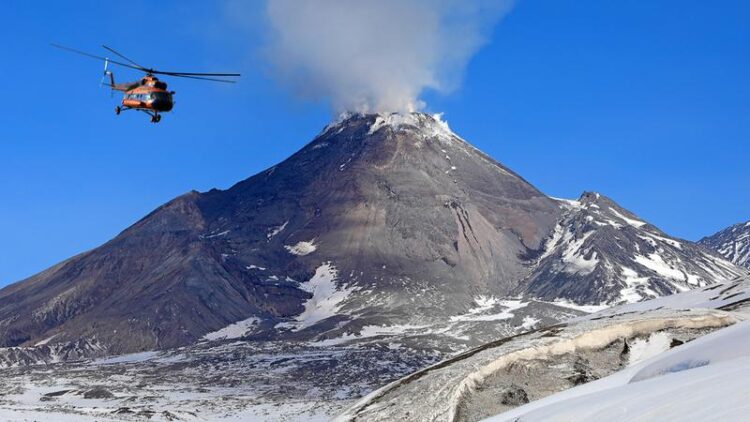Rebirth of a volcano

Bezymianny is an active stratovolcano on the Kamchatka peninsula in eastern Russia.
(Photo: GFZ)
For the first time, long-term photogrammetic series document the “life cycle” of a volcano. The analyses shows that volcanoes have a kind of memory.
Volcanoes are born and die – and then grow again on their own remains. The decay of a volcano in particular is often accompanied by catastrophic consequences, as was the most recent case for Anak Krakatau in 2018. The flank of the volcano had collapsed sliding into the sea. The resulting tsunami killed several hundred people on Indonesia’s coast.
Continued volcanic activity after a collapse has not been documented in detail so far. Now and for the first time, researchers from the German Research Center for Geosciences GFZ and Russian volcanologists are presenting the results of a photogrammetric data series spanning seven decades for the Bezymianny volcano, Kamchatka, in the journal Nature Communications Earth and Environment. First author Alina Shevchenko from GFZ says, “thanks to the German-Russian cooperation we were able to analyze and reinterpret a unique data set”.
Bezymianny had a collapse of its eastern sector in 1956. Photographs of helicopter overflights from Soviet times in combination with more recent satellite drone data have now been analyzed at GFZ Potsdam using state-of-the-art methods. The images show the rebirth of the volcano after its collapse. The initial re-growth began at different vents about 400 meters apart. After about two decades, the activity increased and the vents slowly moved together. After about fifty years, the activity concentrated on a single vent, which allowed the growth of a new and steep cone.
The authors of the study determined an average growth rate of 26,400 cubic meters per day – equivalent to about a thousand large dump trucks. The results make it possible to predict when the volcanic building may once again reach a critical height, so that it may collapse again under its own weight. The numerical modeling also explains the changes in stress within the volcanic rock and thus the migration of the eruption vents. Thomas Walter, volcanologist at the GFZ and co-author of the study, summarizes: “Our results show that the decay and re-growth of a volcano has a major impact on the pathways of the magma in the depth. Thus, disintegrated and newly grown volcanoes show a kind of memory of their altered field of stress”. For future prognosis, this means that the history of birth and collapse must be included to be able to give estimates about possible eruptions or imminent collapses.
###
Original study: A. Shevchenco et al.: “The rebirth and evolution of Bezymianny volcano, Kamchatka after the 1956 sector collapse” in Nature Communications Earth and Environment, DOI: 10.1038/s43247-020-00014-5
Scientific contact:
Dr. Thomas Walter
Group Leader in the GFZ section Physics of Earthquakes and Volcanoes
Helmholtz Centre Potsdam
German Research Centre for Geosciences GFZ
E-mail: thomas.walter@gfz-potsdam.de
Phone: +49 331 288-1253
Media Contact
All latest news from the category: Earth Sciences
Earth Sciences (also referred to as Geosciences), which deals with basic issues surrounding our planet, plays a vital role in the area of energy and raw materials supply.
Earth Sciences comprises subjects such as geology, geography, geological informatics, paleontology, mineralogy, petrography, crystallography, geophysics, geodesy, glaciology, cartography, photogrammetry, meteorology and seismology, early-warning systems, earthquake research and polar research.
Newest articles

Magnetic Memory Unlocked with Energy-Efficient MRAM
Researchers from Osaka University introduced an innovative technology to lower power consumption for modern memory devices. Stepping up the Memory Game: Overcoming the Limitations of Traditional RAM Osaka, Japan –…

Next-Level System Security: Smarter Access Control for Organizations
Cutting-Edge Framework for Enhancing System Security Researchers at the University of Electro-Communications have developed a groundbreaking framework for improving system security by analyzing business process logs. This framework focuses on…

How Microbial Life Shapes Lime Formation in the Deep Ocean
Microorganisms are everywhere and have been influencing the Earth’s environment for over 3.5 billion years. Researchers from Germany, Austria and Taiwan have now deciphered the role they play in the…



